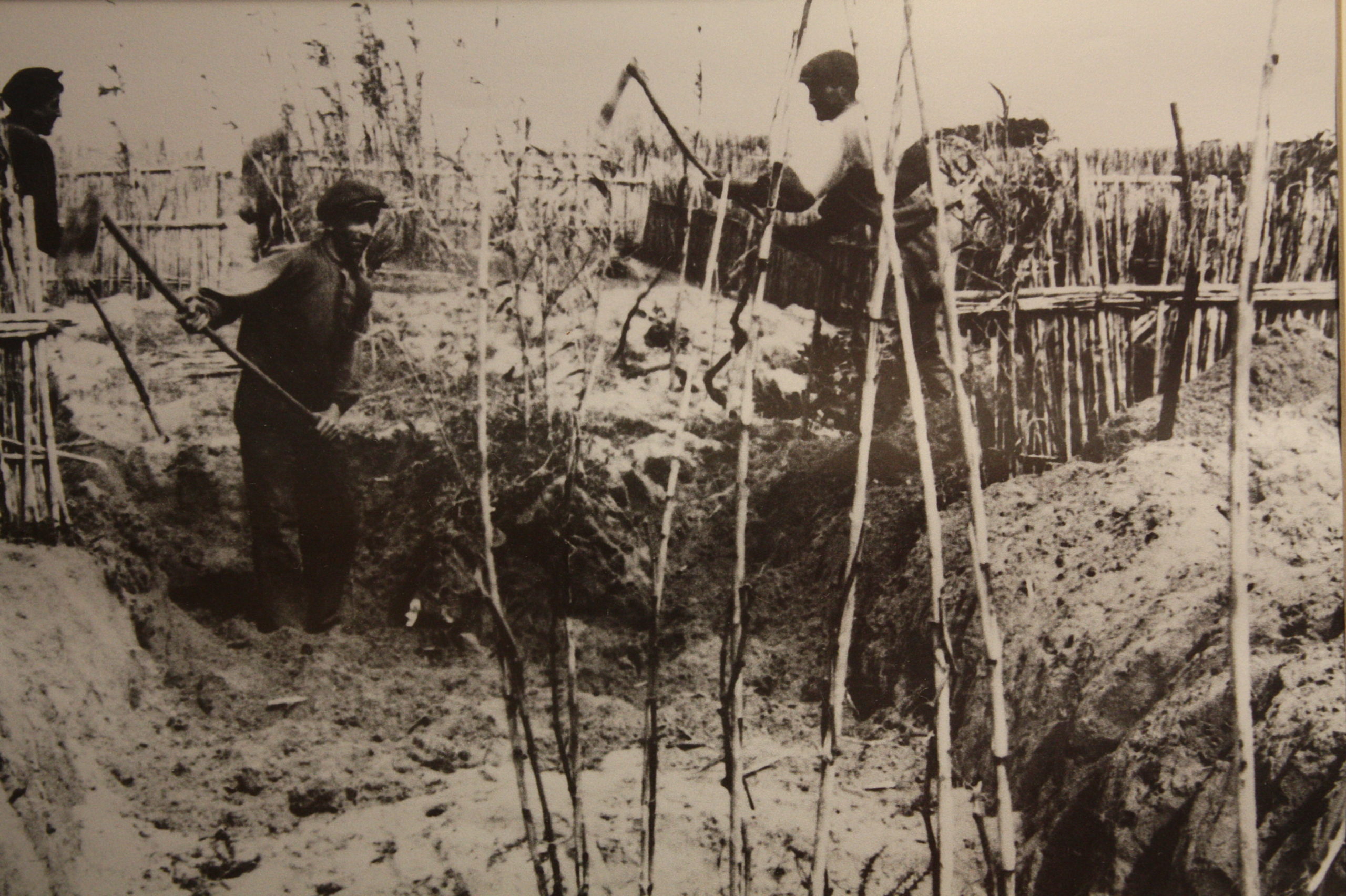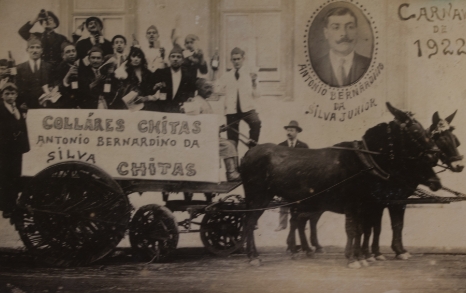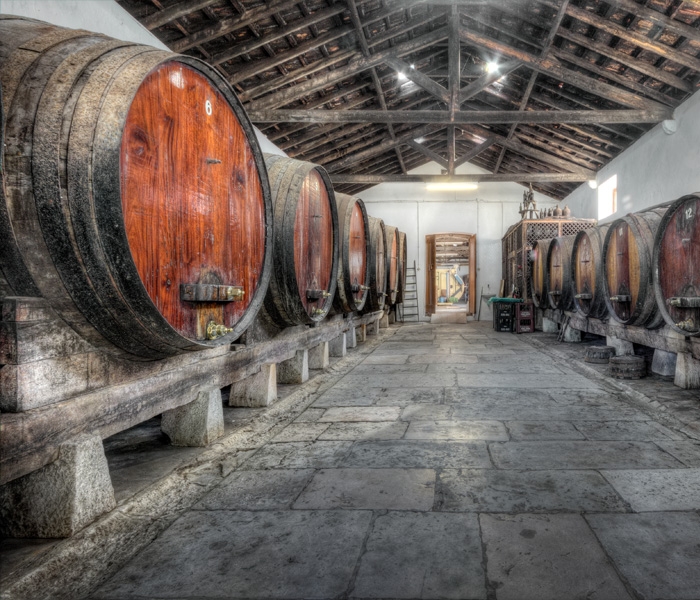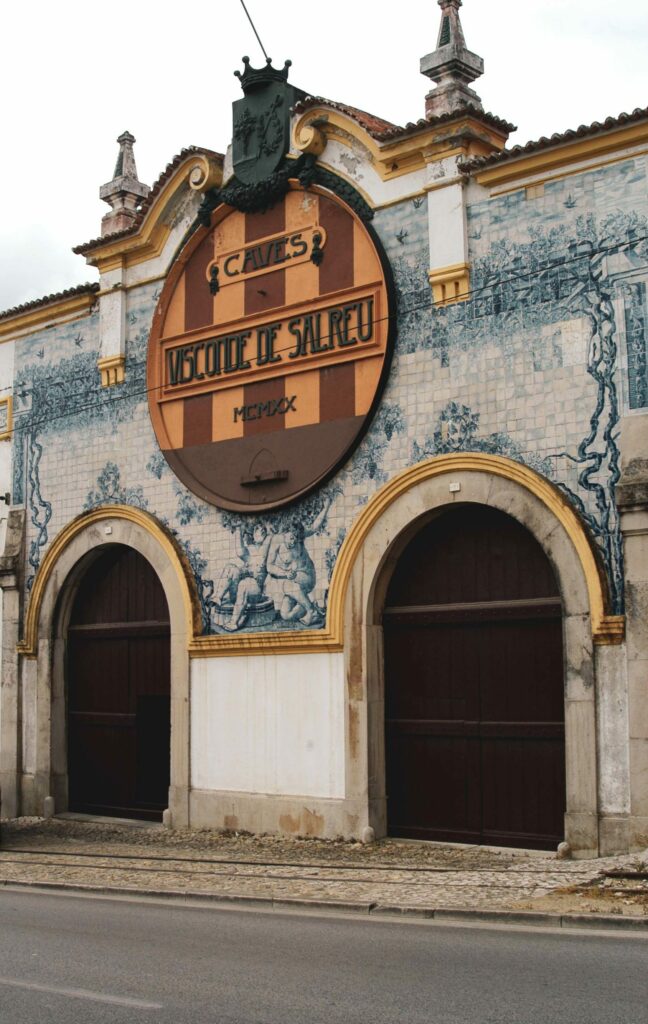António Bernardino da Silva Chitas dedicated his life to winemaking in the Colares region.
The extreme and demanding care with the vineyards in sandy soils, together with the creation of a winery, in modern facilities for the time, in Azenhas do Mar, next to Praia das Maças, contributed to highlighting the Colares Chitas Wine as one of the best in the world. region, widely appreciated throughout the country.
“My grandfather was called António Bernardino da Silva Chitas. He was the foreman of Manuel José Colares, who was a man who exported wine to Brazil. He watched the export and did all that back then. He was a dedicated man, a distinguished worker.
Manuel José Colares had a son, Luís Augusto Colares. He owned all these lands in the area. As he no longer had a family, he distributed a part of these vineyards and cellars to my grandfather.
It was in 1898 that my grandfather started his part.”
António Bernardino Paulo da Silva





The sons of António Bernardino da Silva Chitas – Hermenegildo, João and António (father of António Bernardino Paulo da Silva) accompanied him, from an early age, in his life project, gaining a taste for the activity and giving continuity to his dream.



In 1898, Adega Collares Chitas was founded by António Bernardino da Silva Chitas.
The following year, his children acquired some private wineries that had been operating in the region since the mid-19th century, expanding the firm’s sphere of action.
In the early days, wine was sold mainly in the Lisbon region and exported to Brazil.
The global socio-economic crisis in the 1930s had a strong impact on wine sales to Brazil, affecting traders in the Colares region.
One of the brothers, António Bernardino da Silva Júnior, and his son António Bernardino Paulo da Silva, grandson of the founder of the Adega, made an effort to face this crisis, trying to recover wine exports, expanding its distribution to other countries. from Europe and to the United States of America.
In 1944, António Bernardino da Silva Júnior created the Adega Beira-Mar.
Adega Beira-Mar was built in 1944 by António Bernardino da Silva Chitas Júnior, father of Paulo da Silva, on a plot of land located next to the road that connects Praia das Maças to Azenhas do Mar.
“My uncle Joaquim Caetano said to my father:
– Oh António Chitas, don't you do the Cellar?
– I do, I do!
– Look, António Chitas, if you make the Adega, I'll give you the lamb!
And he gave the lamb for the opening day of the Cellar!
Adega Beira-Mar was opened in 1944, at the time of the harvest.
My father wanted to make the wine down here now.
At that time, it was lunch in the middle of the Cellar.
A pig was killed here. We had pigs, we had cows, we had donkeys, horses…
We had everything here like this.”
António Bernardino Paulo da Silva


Maria de Jesus, wife of Paulo da Silva, was born in 1936. They met in Banzão, where he lived and worked in the office of his father, Inocêncio Jorge da Silva, who had a sawmill and was also dedicated to the wine business.
They got married in 1961 and, since then, he has also started to collaborate in the works of Adega Beira-Mar, playing a very important role in its functioning and growth.
The quality of a wine depends on several factors. It is worth noting the exposure of the vineyard, the nature of the soil, the varieties, the cultivation system, the care in the various operations on the vineyards, but also the vinification processes, the care in manufacture, conservation and storage.
Adega Beira-Mar has fourteen wine brands: Beira Mar, Casal da Azenha, Colares Chitas, Ribamar, Beira Mar Reserva or Garrafeira, Paulo da Silva, Carunchosa, Camejo, Casal Silva, Casal Chitas…






Over time, Adega Beira-Mar’s Colares wines have been exported to several countries:
Brazil, United States of America, Netherlands, Belgium, England, Germany and Norway
The Beira-Mar Winery and the sand-floored vineyards have aroused curiosity and interest on the part of foreigners, receiving several visits for many years.
Colares wines were often served at royal banquets or were part of the meal menus offered to international personalities at the Sintra National Palace.
Paulo da Silva remembers the visit of Queen Isabel II in 1985.
Due to their recognized quality, Colares wines were even part of the offers made by the Presidency of the Republic of Ramalho Eanes.
The different wine brands Colares Chitas, Casal da Azenha, Carunchosa, Ribamar and Paulo da Silva Garrafeiras have participated in national and international competitions over time, achieving several awards through the attribution of gold, silver medals, honorable mentions.





Always investing in future projects, António Bernardino Paulo da Silva bought Caves Visconde de Salreu on July 7, 1994.
With a capacity of one million litres, the Adegas de Salreu could store their wine, which was at the Junta Nacional de Vinhos, which, however, closed on July 30, 1994.
Adega Beira-Mar had all the barrels and deposits full of wine.
The cellars were built by the Viscount of Salreu in Banzão, in 1920. Designed by the architect Norte Júnior, the building had very good conditions at the time to store large amounts of wine in barrels.
Later, in the 60s of the 20th century, it was equipped with large deposits that allowed the storage of about one million liters (see liters), such was the volume of exports to Brazil, Angola, Mozambique and other countries. The wines of this Cellar have reached great quality.
The space has very special conditions for a future project.
Born in 1927, at the age of 93, António Bernardino Paulo da Silva does not stop, always busy and attentive to everything that goes on in the vineyards, in the cellars, with the wines they produce, with the workers and with the family.
For you, time is always short.
For you, time is always short.

António Bernardino da Silva Chitas dedicated his life to winemaking in the Colares region.
The extreme and demanding care with the vineyards in sandy soils, together with the creation of a winery, in modern facilities for the time, in Azenhas do Mar, next to Praia das Maças, contributed to highlighting the Colares Chitas Wine as one of the best in the world. region, widely appreciated throughout the country.

“My grandfather was called António Bernardino da Silva Chitas. He was the foreman of Manuel José Colares, who was a man who exported wine to Brazil. He watched the export and did all that back then. He was a dedicated man, a distinguished worker.
Manuel José Colares had a son, Luís Augusto Colares. He owned all these lands in the area. As he no longer had a family, he distributed a part of these vineyards and cellars to my grandfather.
It was in 1898 that my grandfather started his part.”




The sons of António Bernardino da Silva Chitas – Hermenegildo, João and António (father of António Bernardino Paulo da Silva) accompanied him, from an early age, in his life project, gaining a taste for the activity and giving continuity to his dream.



In 1898, Adega Collares Chitas was founded by António Bernardino da Silva Chitas.
The following year, his children acquired some private wineries that had been operating in the region since the mid-19th century, expanding the firm’s sphere of action.
In the early days, wine was sold mainly in the Lisbon region and exported to Brazil.
The global socio-economic crisis in the 1930s had a strong impact on wine sales to Brazil, affecting traders in the Colares region.
One of the brothers, António Bernardino da Silva Júnior, and his son António Bernardino Paulo da Silva, grandson of the founder of the Adega, made an effort to face this crisis, trying to recover wine exports, expanding its distribution to other countries. from Europe and to the United States of America.
In 1944, António Bernardino da Silva Júnior created the Adega Beira-Mar.

Maria de Jesus, wife of Paulo da Silva, was born in 1936. They met in Banzão, where he lived and worked in the office of his father, Inocêncio Jorge da Silva, who had a sawmill and was also dedicated to the wine business.
They got married in 1961 and, since then, he has also started to collaborate in the works of Adega Beira-Mar, playing a very important role in its functioning and growth.
The quality of a wine depends on several factors. It is worth noting the exposure of the vineyard, the nature of the soil, the varieties, the cultivation system, the care in the various operations on the vineyards, but also the vinification processes, the care in manufacture, conservation and storage.
Adega Beira-Mar has fourteen wine brands: Beira Mar, Casal da Azenha, Colares Chitas, Ribamar, Beira Mar Reserva or Garrafeira, Paulo da Silva, Carunchosa, Camejo, Casal Silva, Casal Chitas…






“I like them all. They are wonderful wines. They have special tastes.”
Over time, Adega Beira-Mar’s Colares wines have been exported to several countries:
Brazil, United States of America, Netherlands, Belgium, England, Germany and Norway
The Beira-Mar Winery and the sand-floored vineyards have aroused curiosity and interest on the part of foreigners, receiving several visits for many years.
Colares wines were often served at royal banquets or were part of the meal menus offered to international personalities at the Sintra National Palace.
Paulo da Silva remembers the visit of Queen Isabel II in 1985.
Due to their recognized quality, Colares wines were even part of the offers made by the Presidency of the Republic of Ramalho Eanes.
The different wine brands Colares Chitas, Casal da Azenha, Carunchosa, Ribamar and Paulo da Silva Garrafeiras have participated in national and international competitions over time, achieving several awards through the attribution of gold, silver medals, honorable mentions.





Always investing in future projects, António Bernardino Paulo da Silva bought Caves Visconde de Salreu on July 7, 1994.
With a capacity of one million litres, the Adegas de Salreu could store their wine, which was at the Junta Nacional de Vinhos, which, however, closed on July 30, 1994.
Adega Beira-Mar had all the barrels and deposits full of wine.
The cellars were built by the Viscount of Salreu in Banzão, in 1920. Designed by the architect Norte Júnior, the building had very good conditions at the time to store large amounts of wine in barrels.
Later, in the 60s of the 20th century, it was equipped with large deposits that allowed the storage of about one million liters (see liters), such was the volume of exports to Brazil, Angola, Mozambique and other countries. The wines of this Cellar have reached great quality.
The space has very special conditions for a future project.
Born in 1927, at the age of 93, António Bernardino Paulo da Silva does not stop, always busy and attentive to everything that goes on in the vineyards, in the cellars, with the wines they produce, with the workers and with the family.
For you, time is always short.
For you, time is always short.


“O meu tio Joaquim Caetano disse para o meu pai:
– Ó António Chitas, tu não fazes a Adega?
– Faço, faço!
– Olha, António Chitas, se fizeres a Adega, eu dou-te o carneiro!
E deu o carneiro para o dia da inauguração da Adega!
A Adega Beira-Mar foi inaugurada em 1944, na altura da vindima.
O meu pai quis fazer já o vinho cá em baixo.
Naquele tempo, era um almoço no meio da Adega.
Matou-se aqui um porco. A gente tinha porcos, tinha vacas, tinha burros, cavalos…
A gente tinha tudo aqui assim.”
António Bernardino Paulo da Silva
“My uncle Joaquim Caetano said to my father:
– Oh António Chitas, don’t you do the Cellar?
– I do, I do!
– Look, António Chitas, if you build the cellar, I’ll give you the lamb!
And he gave the lamb for the opening day of the Cellar!
Adega Beira-Mar was opened in 1944, at the time of the harvest.
My father wanted to make the wine down here now.
At that time, it was lunch in the middle of the Cellar.
A pig was killed here. We had pigs, we had cows, we had donkeys, horses…
We had everything here like this.”
António Bernardino Paulo da Silva
These chestnut and mahogany wooden barrels had belonged to the Casa de Ludgero Gomes, in Almoçageme, and had later been delivered to Tirol. They came to Adega Beira Mar in exchange for wine.
These barrels belonged to the winery of António Bernardino da Silva Chitas, grandfather of Paulo da Silva. They were received by their father through shares between the heirs and the Society.